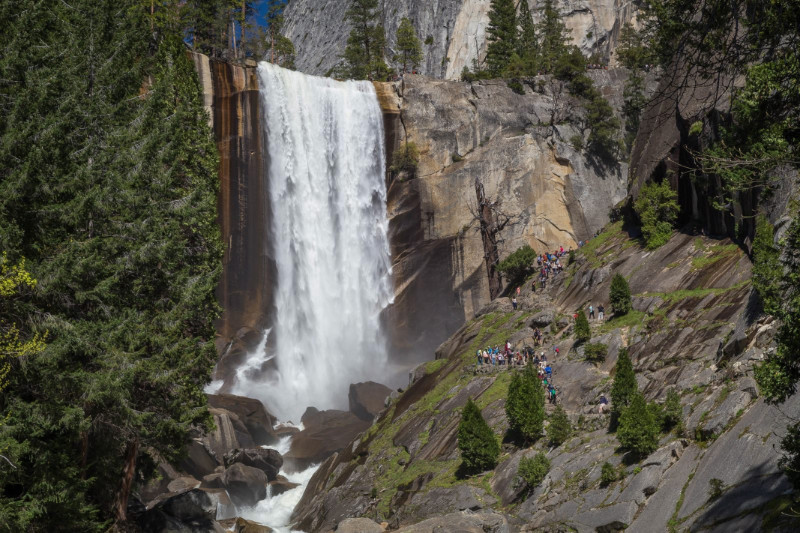18 Important Hiking Safety Tips
From a Search and Rescue Team
There’s a lot of world to explore out there, and we want you to be safe on your hikes. On this page, we’ll share some of what we’ve learned from our search and rescue experiences on how to stay safe on your own hikes and on wilderness outings.
Table of Contents:
Grab Our Quick Guide
Sign up for our newsletter to receive a free copy of our Hiking Safety Quick Guide.
Assess Risks
Assess the risks before starting your hike.


A SAR team carries out an injured hiker in a rescue litter.
1. What does SAR see?
One of the secrets of Search and Rescue is that we don’t see new ways that hikers get into trouble. We see the same causes again, and again, and again.
Most SAR incidents are caused by:
- Bad planning
- Bad preparation
- And sometimes . . . bad luck
2. Consider both risk and consequences
When you think about risk, you need to judge two separate factors:
- The likelihood of an event
- The potential impact of an event.
The likelihood of being in a car crash is low. Would you drive without seatbelts, airbags, or child safety seats? But would you drive without seatbelts?

The consequences of injuring your leg in the wilderness may be dramatically different from injuring your leg at home.

3. Hypothermia
In the Pacific Northwest, the most important risk to lost or injured hikers is hypothermia: a pathological lowering in body temperature.
- Hypothermia can sneak up on you.
- Early symptoms: Fatigue, confusion.
- Moderate symptoms: Impaired decision-making
- Moderate symptoms: May include shivering
- Severe symptoms: Shivering stops
- Severe symptoms: Cardiac arrest (death)
Contributors to Hypothermia
-
Temperatures in 50s or below
-
Rain, wind, or snow
-
Clothes wet from rain or sweat
-
Cotton clothes that wick away heat
-
Consumption of alcohol
-
Age: (young or elderly)

4. What’s your hiking risk profile?
Take a minute to sum your points to see your Safety Rating / Risk Profile.
What things could you do to improve for your next hike?
| Increases Your Risk | Points |
|---|---|
|
Hike alone |
-3 |
|
Selfies near cliffs |
-2 |
|
Step Over Railings |
-2 |
|
Trail Runner |
-1 |
|
Hike in Weather Window |
-1 |
|
Unfamiliar Areas |
-1 |
|
No Map/Compass Skills |
-1 |
|
No cell phone |
-1 |
|
Dog(s) off-leash |
-1 |
| Decreases Risk | Points |
|---|---|
|
Hike with companions |
+2 |
|
Research your route |
+1 |
|
Leave a trip plan |
+1 |
|
Check weather forecast |
+1 |
|
Carry 10 Essentials |
+1 |
|
Carry charged cellphone |
+1 |
|
Practice map & compass |
+1 |
|
Wear layered synthetics |
+1 |
|
Boots with ankle support |
+1 |

5. Attention trail runners!
Factors that increase a trail runner’s risk profile:
- Traveling solo
- Low shoes, with no ankle support
- Traveling with minimal gear, water, food
- Leaving cell phone behind
- Ability to travel long distances into wilderness areas – farther away from help

Unsafe Trail Runner

Better Prepared Trail Runner
If you're a trail runner, you should always:
- Tell someone your planned route.
- Do not ignore forecast storms.
- Do not run in extremely hot weather.
- Consider carrying a satellite beacon.
6. The “ULTRALIGHT” trend
The desire to carry the least weight possible is perfectly understandable. But it’s important to remember that:
- The recent “ultralight” fad is driven by companies who want you to buy that next piece of expensive gear.
- Somehow in previous decades, hikers have miraculously managed to enjoy the outdoors without all the latest ultralight gear.
Consider your basis for making “ultralight” decisions.
OK
Replace the same functionality with items that weigh less.
Example: Spending $10 for a titanium backpacking spoon.
NOT OK
Leave some gear behind in the hope that you won’t need it.
Example: Leaving microspikes at home, hoping it won’t be icy.
Prepare & Prevent
The right mindset, gear, and research for your hike.


7. The Safe Hiker Mindset
Unsafe hikers think:
“What could possibly go wrong?”
Safe hikers think:
“What could possibly go wrong? . . . And how could I be prepared to deal with it?”
Unfortunately, a large portion of hikers that you will see at any trailhead are not prepared for bad weather or getting lost or injured.
Unsafe hikers prepare for what they expect. Safe hikers prepare for the unexpected.
8. The Eleven Essentials
Try this experiment:
- Take all the gear you had with you on your last hike.
- Spend the entire night outdoors in your backyard.
Did you stay warm and dry?
Do you need to re-think what you carry in your pack?


9. Research Your Hike
Use guidebooks and hiking websites to learn about:
- The length and elevation gain.
- Local hazards
Get a good topographical map of your trail and the surrounding area.
Check the weather and avalanche forecast.
Know before you go!
How long will it be? How high will I climb? What terrain and weather will I encounter?
10. Boots and Bugs
Be wary of the recent fad for hiking in low, lightweight shoes with no ankle support.
While the risk of injuring your ankle may seem low, the consequences (immobility, overnight exposure to the elements, hypothermia, medical treatment expenses) can be very serious indeed.

A net bug hat weighs next to nothing and can be worth its weight in gold!

Boots that support and prevent injury to your ankles are also important.

11. Fashion for Hiking Safety
- Carry multiple synthetic layers, and adjust your layering as you go.
- Avoid cotton, which will wick heat from your body when wet or cold.
- Wearing fashionable dark clothing will make it impossible for SAR to find you.
- Don’t forget hats and sunglasses.
- Bright, unnatural colors will stand out.
12. About that cell phone
How having a cell phone can save you:
- SAR can obtain your location from your cell phone – even if you can’t call.
- When SAR has your location, it can reduce your rescue time from days to hours.
- Conserve your battery during your hike!
- If your battery is low, call 911 first – they can get your coordinates and relay to SAR.
- Text messages may get through even when voice reception is poor.

This hiker was located after 17 days in the forest. There was cell phone service where she was found. Her cell phone was left in her car.
Situational Awareness
Be alert to the potential hazards out there!


13. Warning Signs
- When is it safe to ignore warning signs? NEVER.
- Understand that warning signs are only placed after someone else has been injured before you.
- It’s also important to understand that in a natural environment, many hazards exist with no warning signs!
- Maintain your situational awareness, and watch for cliffs, hidden drop-offs, geological hazards, slippery surfaces, weak snow bridges, and swift-moving water.
Yes, you need to read all the signs!
14. When is a hike a climb?
Take this quick assessment to see if you need special equipment.
Exposure to Falling
Is there a risk of falling during your hike?
High Mountain Terrain?
Does your hike involve high mountain terrain?
Crosses Ice or Snow?
Would a slip lead to injury or worse?
You're on a climb!
Safe travel requires special training, special gear, and extra caution.
You're on a hike!
OK to proceed with normal caution, and situational awareness.
Changes in terrain or weather can turn a hike into a climb!

15. Not Disneyland
| Safety Features | Disneyland | Natural Wilderness |
|---|---|---|
| Engineered for safety | ✅ | ❌ |
| Safety monitors on duty | ✅ | ❌ |
| Ready access to first aid | ✅ | ❌ |
| Ready access to transportation | ✅ | ❌ |
Enter natural wilderness areas with equal measures of respect and caution. Most hikers will have a safe, enjoyable time…but sadly, not all of them.





16. Attractant Hazards
We humans are fascinated and attracted by high places, waterfalls, river gorges, craters, hot geysers, and ice caves.
The rule for Attractant Hazards is: “The closer you get; the greater the danger.”
- DO NOT cross railings.
- Keep kids and dogs under control.
- DO NOT get close for selfies.

Vernal Falls in Yosemite National Park
Death Rate = 1 person every 2 years

A fall into this torrent could easily be fatal.
17. Crossing Rivers
Rivers rise with recent rainfall and or increased temperatures. Consider turning around, or waiting for levels to drop.
If you decide to cross:
- Cross early in the day.
- Unbuckle your pack waist strap.
- Have a safety person downstream with a rope to throw.
18. Travelling on Snow
Moving safely on snow is not a natural talent, and requires training and practice.
Traveling on snow (or ice) requires specialized clothing, boots, gear, and traction devices.
Snow hazards include: slippery slopes; holes near rocks; tree wells; crevasses; weak snow bridges, and avalanches.

If you slipped on this slope, would you have the gear (ice axe) and training (how to self-arrest) to prevent sliding into the rocks (or over the cliff) below?

